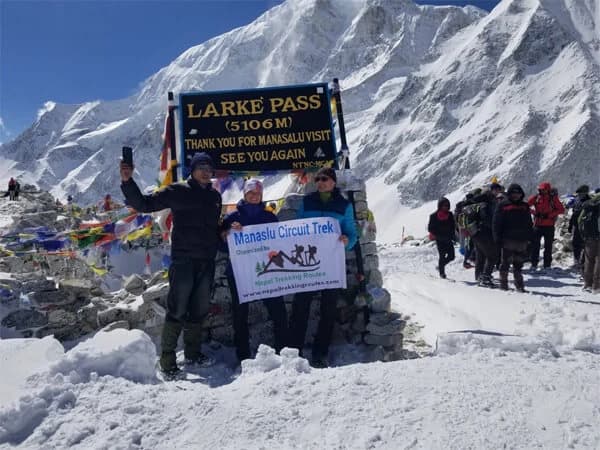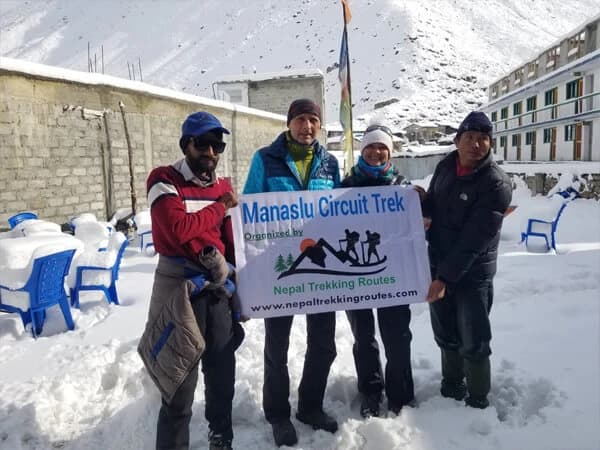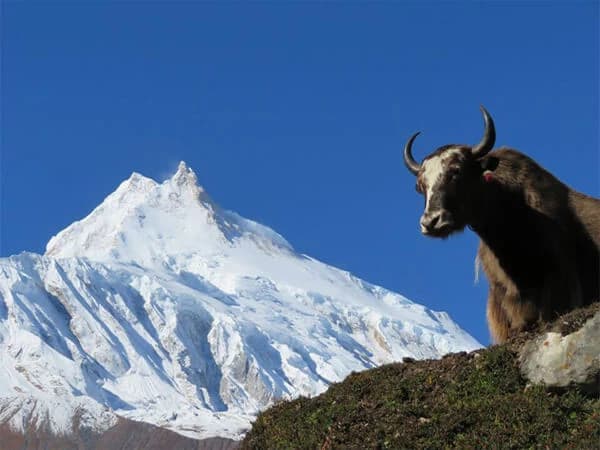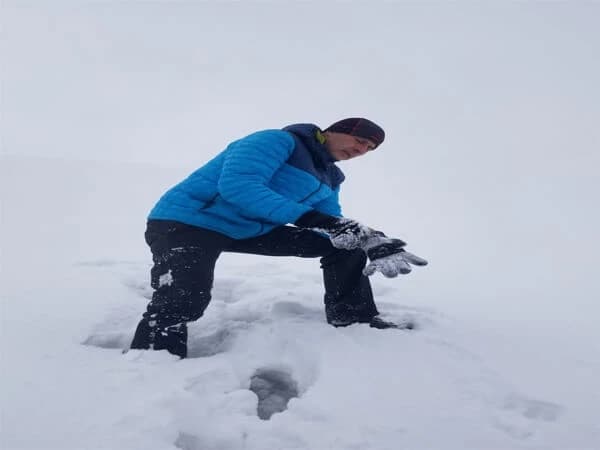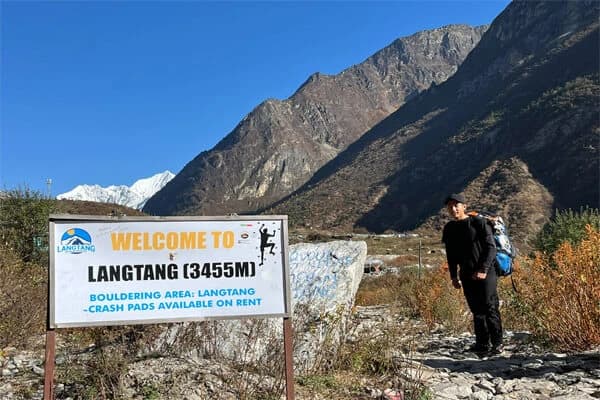There are rough trails, steep climbs, and high-altitude parts like Larkya La Pass (5,160m) that make the Manaslu Circuit Trek moderately to extremely difficult. Acclimatization, readiness, and physical fitness are crucial. Despite its challenges, the journey offers trekkers breathtaking Himalayan vistas, Tibetan-influenced culture, and remote wilderness experiences.
What are the Manaslu Trek Difficulty?
Manaslu Trek is the finest trek that covers the region of Gorkha and Lamjung. The trek is often considere to be perfect for having less crowd and amazing wonders it possesses in its himalaya. Mount Manaslu being the eighth highest mountain in the world, charms every voyager passing by. Despite having such a beautiful presence, why does the place have very few trekkers? Difficulties and challenges that is what gives the thrill to trekkers at Manaslu Round Trek with an amazing life lasting memory.
How Difficult is Manaslu Circuit Trek?
For an average trekker who has a prior experience in trekking fields, Manaslu Trek is consider to be challenging one. Manaslu Trek Difficulty is grade as a difficult one for the trekkers with experience. If you plan to do the first trek in the Manaslu route, then Manaslu Round Trek will cost you a lot of effort. Manaslu Trek is categorized as one of the long distance trekking that takes a few weeks to a month to complete. However, if you want to do the trek desperately and sit in the lap of himalayas admiring nature, then there are some facts about Manaslu Region you need to know while accessing the trekking route. The route was opened for foreigners only in the 1990's.
The roads and transportation were extremely difficult to reach Manalsu Region. So, before you go for the Manaslu Round Trekking be prepared with some extra knowledge that can always come handy during your memorable journey in those off beaten paths.
Some facts of Manaslu Round Trek
Distance and Duration:
Categorized under the long and challenging trek, Manaslu Round Trek roughly takes 2 to 3 weeks to complete the trek. The whole circuit covers a walking distance of 175 km. As I already mention, Manaslu Round Hiking is consider as Challenging trek. That is because you have to walk nearly 6 to 8 hours of ups and down in the trekking trail with backpacks. You can also find potters and backpack carriers paying some extra cash. The trial starts from the western region of Nepal, Gorkha. When you reach the trailhead by means of vehicles. You cannot move further unless you are on your foot. Starting from day 1 of the trek you have to walk roughly 6 to 8 hours depending upon your capabilities for straight 2 weeks. The distance and the durations is what makes the Manaslu Trek difficulty one.
Manaslu Trek Altitude and Weather
Mt. Manaslu being the eight highest mountain in the world has base camp at an altitude of 4,800 m height. We will pass through the base camp and reach Manaslu Larke Pass which is an altitude of 5,100 m. Along with the trekking difficulties, the oxygen level also reduces from the atmosphere causing several trekkers altitude sickness. You must drink water often to be hydrate.
Due to the elevating altitude there are uncertain and frequent changes in the weather. If you trek in the winter season the temperature almost falls to -12 degrees. The snowy trails make the trek even more difficult. Sometimes the trail gets inaccessible which may result in a rest day or hike to another destination. Also, at the lower regions of the trek like Setikhola the temperature goes up to 8 degree Celsius. Larke Pass which is the highest point in our trek is mostly cover with snow. After you cross Samdo, the weather becomes terrible so a guide is compulsory if you go trekking onward.
Manaslu Trek Fitness Level Required
Due to the moderate to extremely difficult nature of the Manaslu Trek, a high degree of physical condition is necessary. Trekkers should be able to trek 6–7 hours a day on steep, rocky, and high-altitude terrain. At Larkya La Pass, where the trek reaches 5,160 meters, the thin air makes breathing difficult and raises the possibility of altitude sickness. It is advised to engage in regular aerobic activities such as swimming, cycling, jogging, or hiking for at least four to six weeks prior to the expedition. Stamina, core stability, and strong legs are crucial. Although you do not have to be athletic, having strong mental and physical stamina is essential for a fun and safe trip.
Manaslu Trek Challenges and Terrain
With a variety of environmental and physical challenges, the Manaslu Trek offers a genuine journey into one of Nepal's most isolated and untamed areas. At lower elevations, the trail traverses terraced rice fields, lush subtropical forests, and traditional communities; at higher elevations, it traverses rocky slopes, alpine meadows, and high mountain passes. Trekkers must pay close attention and use caution when crossing suspension bridges, narrow pathways, and occasionally landslide-prone areas.
The greatest challenge is the huge elevation, particularly while traversing the 5,160-meter Larkya La Pass. Trekkers who want to avoid altitude sickness must be careful about acclimatization. Unpredictable weather patterns include heavy rainfall, slippery trails, and possible river floods during the monsoon season, while the trail may be snowy and ice in the spring and fall.
Remoteness is another difficulty because some communities lack basic amenities, forcing hikers to bring necessary equipment and rely on nearby teahouses for shelter and meals. Managing the lengthy trekking days and high ascents requires mental toughness, physical endurance, and meticulous preparation.
Despite these difficulties, the Manaslu Trek is one of Nepal's most remarkable trekking experiences, offering trekkers tranquil lakes, rich Tibetan-influenced culture, a sense of unspoiled nature, and stunning Himalayan views.
Manaslu Circuit Trekking Acclimatization
Acclimatization is important part of the Manaslu Circuit Trek due to the high altitudes, with the trail reaching Larkya La Pass at 5,160 meters. Trekkers should adhere to the "climb high, sleep low" philosophy, which calls for a steady ascent to give the body time to acclimate to the thinner air. Samagaon, Manang, and Tilje are important acclimatization sites where hikers can rest and make quick daytime ascents.
It is best to stay in Manang for an additional day before heading toward Larkya La so that the body has time to make more red blood cells for the transportation of oxygen. It is crucial to drink enough of water, abstain from alcohol, eat small meals, and pay attention to your body. Appropriate acclimatization guarantees a safer, more pleasurable trek and lowers the danger of altitude sickness.
Manaslu High Passes Difficulty
The high passes of the Manaslu Circuit Trek, especially the 5,160-meter-high Larkya La Pass, are one of its most distinctive challenges. For trekkers getting ready for this journey, it is crucial to understand the Larkya La Pass difficulty. The pass calls for a combination of mental toughness, physical stamina, and appropriate acclimatization. Each step on the Larkya La trail is physically taxing due to the long, steep ascents on stony, occasionally snowy pathways and the dwindling air.
Snow, ice, or strong winds can make navigation difficult, adding to the Larkya La Pass difficulty. If there is snow, trekkers need to bring important equipment including crampons, warm clothes, and trekking poles. Careful footing is necessary for the steep and rocky descent toward Bimtang or Dharapani on the opposite side.
A genuine sense of accomplishment and expansive vistas of Manaslu, Himalchuli, and Ngadi Chuli are the rewards for overcoming the difficulties. Managing the Larkya La Pass challenge requires careful planning, a slow ascent, and acclimatization in villages like Samagaon and Samdo. Through meticulous preparation, this high pass turns from a difficult challenge into one of the Manaslu Circuit is most unforgettable features.
Physical Preparation for Manaslu Trek
The demanding, high-altitude Manaslu Circuit Trek necessitates strong physical preparation. This walk requires both strength and endurance because it reaches over 5,000 meters at Larkya La Pass, which is higher than lower-altitude treks. Four to six weeks prior to travel, a comprehensive fitness program should start with an emphasis on flexibility, strength training, and cardiovascular conditioning.
Running, cycling, swimming, and brisk walking are examples of cardio sports that assist increase lung capacity and stamina, which are essential for lengthy trekking days. Strength training prepares your body for uneven terrain, uphill climbs, and backpack carrying, especially for the legs, core, and back. Exercises that are very beneficial include planks, squats, lunges, and step-ups.
Stretching or yoga can help you develop flexibility and balance, which lowers your risk of injury on uneven terrain. Furthermore, practice treks with a full backpack on hills or mountains assist boost confidence and replicate trekking situations.
A few nights at a moderate elevation prior to the trek might aid in the body's acclimatization to high elevations, which is a component of preparation. To maximize performance, proper nutrition, relaxation, and hydration are also crucial. Trekkers can navigate the rough terrain, high passes, and lengthy walking days of the Manaslu Circuit safely and joyfully if they are physically prepared.
Best Time to Trek Manaslu for Less Difficulty
If you want to lessen physical strain, stay out of bad weather, and make the trip safer and more pleasurable, timing is everything when it comes to the Manaslu Trek. The pre-monsoon (spring) and post-monsoon (fall) seasons are ideal for the walk because they provide consistent weather, clear skies, and tolerable route conditions.
Manaslu Trek in Spring Season (March to May): Because of the moderate temperatures, melted snow on the lower portions, and generally dry and safe routes, spring is the best time of year for less strenuous trekking. The walk becomes more colorful as the rhododendron trees along the lower slopes bloom gloriously. With the right equipment, navigating higher passes like Larkya La is easier, even though there may still be some snow. Additionally, springtime brings longer daylight hours, which enable hikers to comfortably travel greater distances.
Manaslu Trek in Autumn Season (September - November): Another great season is autumn, which lasts from late September to November. The air is now free of dust thanks to the monsoon, providing breathtaking sweeping vistas of Manaslu, Himalchuli, and the neighboring peaks. Because the trails are firm and dry, there is less chance of landslides or slick conditions, which can make walking more challenging. Although a little lower than in the spring, the daytime temperatures are still tolerable.
It is crucial to avoid the monsoon season (June to August) because of the muddy routes and hazardous river crossings caused by excessive rainfall. The harsh cold, snow, and slippery roads in winter (December to February) make high passes like Larkya La much more challenging.
Planning your trip for spring or fall is the best option for beginners or those seeking a less strenuous and dangerous trek. Good weather, comfortable temperatures, and stable pathways all work together to minimize tiredness and enable hikers to fully appreciate the Manaslu region's highHimalayan scenery, local culture, and natural beauty.
Manaslu Circuit Trekking Conditions
The Manaslu Circuit Trek offers a variety of trekking conditions, from alpine meadows, steep slopes, and glacier terrain at higher elevations to subtropical woods and terraced farmlands in the lower sections. There may be suspension bridges, landslide-prone spots, steep, narrow, and uneven trails. Seasonal variations in weather include clear sky and mild temperatures in the spring and fall, heavy rain and slick roads during the monsoon, and snow and ice during the winter, which make conditions more challenging. Acclimatization and cautious pace are necessary for high-altitude parts, particularly those close to Larkya La Pass (5,160m). Trekking safely and comfortably requires preparation, fitness, and the right equipment.
Food and Accomodation:Manaslu Trek Difficulty
Before the 1990's there weren't any signs of development. So, trekking the Manaslu Circuit was almost impossible. However, as the time pass different tea houses, and home stays were start by the locals to provide services to the voyagers coming by. During this time, the tea houses are equipped with basic facilities to provide services for the trekkers around the world.
You will get typical Nepalese food like Rice and Lentils with proper nutrients and energy that will boost your trekking capabilities for the next day. Besides, peak season, you can easily find good rooms equipped with fine beds.
Manaslu vs Annapurna Difficulty Comparison
Both the Annapurna Circuit Trek and the Manaslu Circuit Trek are well-known Himalayan treks, but they vary greatly in terms of accessibility, geography, and degree of difficulty.
Manaslu Trek Difficulty: Most people agree that the Manaslu Circuit is more difficult. There are fewer lodges, fewer rescue possibilities, and smaller routes because it is longer, more isolated, and less commercialized. Trekkers must be well-acclimated and physically ready for hard ascents and possibly ice or snowy weather at the highest point, Larkya La Pass (5,160m). High communities like Samagaon and Samdo have inadequate infrastructure and a slow but steady climb, which increases the risk of altitude sickness. The trail is rougher, with isolated sections, rocky trails, and river crossings.
Annapurna Circuit Difficulty: With a larger network of teahouses, lodges, and emergency services, the Annapurna Circuit is more accessible and somewhat difficult. Although Larkya La is marginally lower than Thorong La Pass (5,416m), the journey is often better supported, with shorter daily lengths in popular portions. Trekkers can use jeep rides to cut portions of the well-established trails.
In conclusion, Annapurna provides a little easier, more assisted trekking experience with cultural and scenic diversity, making it appropriate for intermediate trekkers, whereas Manaslu requires higher levels of fitness, independence, and mental toughness. Both provide breathtaking views of the Himalayas.
Manaslu Restricted Area Trek Challenges
Beyond high-altitude walking, the Manaslu Circuit Trek presents special difficulties due to its restricted region. There are not as many lodges, teahouses, or medical services for trekkers, and they need specific permits. Trails are rough, frequently steep, and feature limited mountain paths, landslide-prone areas, and river crossings. The most physically taxing section is the high-altitude Larkya La Pass (5,160m), which necessitates cautious acclimatization. The weather can change suddenly, and ice, snow, or rain can make roads dangerously slick. This trek is both adventurous and difficult because of the remote terrain and limited connectivity, which necessitate self-sufficiency, appropriate equipment, and high levels of physical condition.
Altitude Sickness on Manaslu Circuit
Because the Manaslu Circuit Trek reaches as high as Larkya La Pass (5,160m), altitude sickness is a serious risk. Headache, nausea, lightheadedness, exhaustion, and dyspnea are some of the symptoms. Acclimatization is crucial; the body adjusts through steady climbing, rest days in villages like Samagaon and Samdo, and the "climb high, sleep low" philosophy. Additionally, avoiding alcohol and physically demanding activities, eating small meals, and staying hydrated all lower risks. Trekkers should keep a watchful eye on symptoms and get down right once if there are any serious ones. To enjoy this high-altitude Himalayan journey safely, awareness and planning are essential.
Daily Walking Hours on Manaslu Trek
Depending on the region, elevation, and weather, the average daily walking time on the Manaslu Circuit Trek is between 5 and 8 hours. Days at lower elevations, such the journey from Soti Khola to Machha Khola or Chame, are easier and take less time; they often last 5 to 6 hours. While high-altitude days reaching Larkya La Pass or descending to Bimtang or Dharapani might take up to 7–8 hours because of the steep climbs, thin air, and cautious pacing, mid-altitude sections via Dharapani, Tal, and Jagat may take 6–7 hours. Safely regulating daily walking hours requires proper water, rest, and acclimatization.
Manaslu Trek Difficulty for Solo Trekkers
Solo trekkers encounter particular difficulties that call for careful planning and alertness, making the Manaslu Circuit journey a moderately to extremely challenging journey. The trail's remoteness it travels through rural towns with few teahouses, few medical services, and, in certain places, few other trekkers is one of its main challenges. Trekkers who go it alone must be independent, pack necessary equipment, and have backup plans in case of crises.
The trek requires walking over steep, rocky, and occasionally freezing routes for extended periods of time each day typically 5 to 8 hours. Because of the thin air and the possibility of altitude sickness, the high-altitude portion is a significant challenge, particularly the 5,160-meter Larkya La Pass.
For lone hikers, proper acclimatization with rest days in Samagaon or Samdo is essential. In addition, the weather might change suddenly, making the track more challenging to follow in the event of snow, rain, or strong winds. Because some areas are less marked or more vulnerable to landslides, solo hikers should possess strong map-reading, navigation, and survival abilities.
Trekking by yourself provides a sense of autonomy, seclusion, and a closer bond with the Himalayan landscape in spite of these difficulties. Solo trekkers can safely enjoy the Manaslu region's spectacular beauty and cultural diversity if they are well-prepared, physically fit, and mindful of the risks associated with high altitude.
Fitness Training for High-Altitude Treks
Treks at high elevations, like the Annapurna Circuit, Manaslu Circuit, or Everest Base Camp, need exceptional stamina, mental toughness, and physical condition. For a safe and pleasurable experience, preparation is crucial due to the low oxygen levels, high ascents, rocky pathways, and extended walking hours.
Four to six weeks prior to the trek, a comprehensive fitness training program should begin, emphasizing cardiovascular endurance, strength, and flexibility. Running, cycling, swimming, and brisk walking are examples of cardio exercises that increase lung capacity and stamina, which helps your body cope with high altitudes. Given that trekkers will be carrying backpacks and navigating steep, uneven terrain, strength training for the legs, core, and back is essential. Exercises that increase muscle endurance and stability include planks, squats, lunges, and step-ups.
Training for flexibility and balance, such as yoga, Pilates, or stretching, lowers the chance of injury and improves agility on slippery or rocky paths. Your body can adjust to extended daily walking hours by simulating trek circumstances by practicing trekking on slopes or staircases while carrying a full rucksack.
During training, rest, diet, and hydration are equally crucial. A healthy diet and enough sleep promote energy levels and muscle rehabilitation. Trekkers can safely enjoy high-altitude treks, take on difficult routes, and completely experience the Himalayan sceneries if they regularly prepare physically.
Manaslu Trek Difficulty Rating and Safety Tips
One of Nepal's more difficult treks, the Manaslu Circuit Trek combines pristine environment with high-altitude adventure. It is appropriate for trekkers with strong physical condition and previous trekking experience, with a difficulty level of moderate to strenuous. Larkya La Pass is the steepest and most difficult part of the climb, reaching a maximum elevation of 5,160 meters. Depending on the weather, altitude, and terrain, walking can last anywhere from five to eight hours per day. There are rocky trails, steep climbs, narrow ridges, and river crossings, and landslides are common in some places. Because there are fewer lodges and medical services along the route due to its remoteness, preparedness and independence are more important.
Safety Tips for the Manaslu Trek:
- Acclimatize Properly: Include rest days at Samagaon or Samdo; follow “climb high, sleep low.”
- Monitor Health: Watch for symptoms of altitude sickness: headache, nausea, dizziness, fatigue. Descend immediately if severe.
- Physical Fitness: Prepare with cardio, strength training, and flexibility exercises before the trek.
- Hire a Guide or Porter: Especially recommended for solo trekkers or first-timers to navigate difficult trails safely.
- Check Weather Conditions: Avoid monsoon and winter; spring and autumn provide safer, more stable conditions.
- Carry Essential Gear: Warm clothing, trekking poles, crampons (for snow), first-aid kit, and sufficient water.
- Stay Hydrated and Eat Well: Prevent dehydration and maintain energy for high-altitude trekking.
- Travel Permits: Obtain restricted area permits in advance; local authorities may check permits at checkpoints.
- Emergency Planning: Have evacuation plans in case of injury or severe altitude sickness.
Following these tips significantly increases the safety and enjoyment of the Manaslu Circuit Trek, allowing trekkers to experience its spectacular landscapes, Tibetan-influenced culture, and remote Himalayan wilderness with confidence.
FAQs
How difficult is the Manaslu Trek for beginners?
The Manaslu Circuit is moderately to highly challenging. While beginners with good fitness can attempt it, prior trekking experience and preparation are recommended due to long walking hours, steep ascents, and high-altitude conditions.
What is the highest point on the Manaslu Trek?
The trek reaches its highest point at Larkya La Pass (5,160 meters). Crossing this high pass is the most demanding part, requiring careful pacing and proper acclimatization.
How many hours per day do trekkers walk?
Daily walking hours typically range from 5 to 8 hours, depending on the terrain, altitude, and weather. High-altitude days and steep climbs take longer.
What physical fitness is required?
Trekkers should have good cardiovascular endurance, leg and core strength, and stamina. Practice hikes, stair climbing, or hill walks with a loaded backpack help prepare the body.
What safety measures should be taken for Manaslu Trek difficulty?
Acclimatization days, monitoring altitude sickness symptoms, hiring a guide or porter, carrying essential gear, and choosing the best trekking seasons (spring or autumn) are critical for safety.
Is Manaslu Trek suitable for beginners?
The Manaslu Trek is not ideal for complete beginners due to high altitude, long days, and rugged terrain.
Conclusion: Manaslu Trek Difficulty
The Manaslu Circuit Trek is a moderately to extremely difficult trek that puts your mental and physical fortitude to the test. The high-altitude Larkya La Pass (5,160m), rough paths, and steep ascents make preparation, fitness, and acclimatization crucial. Trekkers face more challenges because they have to deal with isolated communities, inadequate amenities, and erratic weather. The trip is manageable, though, thanks to meticulous preparation, slow pace, and safety precautions including hiring guides, keeping an eye out for altitude sickness, and trekking in the spring or fall. Despite its difficulties, the walk offers hikers a sense of accomplishment that will last a lifetime, rich Tibetan-influenced culture, and stunning Himalayan scenery.

.webp&w=3840&q=75&dpl=dpl_4U3CaZUV3Y5iKdBNPJmVMATJy3AB)
